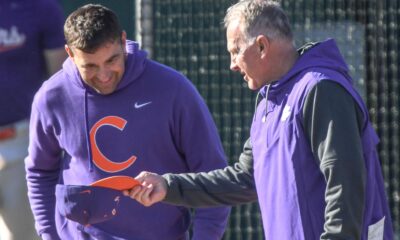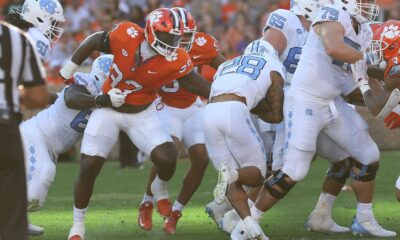
Hurry Up Defense: 2015
It has been a few years since I posted anything about pace of play affecting defenses, but I feel this is a great time to revisit this right after our beloved Tigers defense finished #1 in the nation in Total Defense and F/+.
If you haven’t read the original post from after the 2011 season, you may view that here.
The goal here is, as always, to create thought and let you form you own opinion as we present all the information out there. I will give you my opinion and analysis but you should make up your own mind.
For the past couple years, I had assumed, perhaps wrongly, that it was widely accepted that fast paced HUNH offenses have negative effect on their respective defenses. Until now, I felt the need to spare you a yearly update in favor of just chiming in on message board discussions (most recently, pointing out Vic Koening’s 119th ranked defense at UNC under the HUNH).
However, it has been brought to my attention that a quote from Dabo a couple years ago is making the rounds. Coach Swinney said he “didn’t understand” why people like myself were saying that it is difficult to field both an Elite Offense and an Elite Defense at the same time while running “80 to 85 plays per game.” Coach Swinney added that it was indeed possible and that we would be able to do both at the same time.
Recently, some have concluded that the defensive performance from 2014 is that proof that Clemson can have both a strong offense and a strong defense with Chad Morris’ Hurry Up No Huddle (HUNH) offensive philosophy.
I thought I’d address whether or not it actually is the final proof we need to determine that HUNH offenses and Elite Defenses are not mutually exclusive.
Well, I’ll start by acknowledging that the above statement in bold is true. However, it’s not a new-found revelation brought to light by the Clemson’s defensive performance in 2014, but it is true.
The informed reader at STS already knew that it is possible to have a strong HUNH offense and a top 15 defense (see: Kansas 2007, OU 2009, and Oregon 2010). Just by reading this site, those readers can say that they are officially three years ahead of some who cover Clemson football for a living.
Yes, having a great statistical offense and a great statistical defense has always been possible, it just hasn’t happened at Clemson yet. What really happened this past year is that Dabo and Morris showed that they DO “understand” what their “coachspeak” says they don’t and they proved that this year.
Team
Year
National Scoring Offense
National Scoring Defense
Offense Plays per Game
# Plays Rank
plays per minute rank
plays per minute
Rush %
Time of Poss. rank
Clemson
2012
6
46
81.7
7
9
2.84
55.3
92
Clemson
2013
8
24
79.8
13
9
3.23
53.6
112
Clemson
2014
54
3
76.2
27
51
2.69
53.7
34
As you can see, ranking 51st in “plays per minute” last year does not exactly qualify as the racecar HUNH football we’ve been accustomed to under Chad Morris. What is reflected here by the numbers is a drop in offensive speed in order to benefit the great defense.
Instead of going “fast, fast, fast” all the time, Morris adjusted his strategy and went “slow, slow, slow” until the Tigers achieved a first down. After an initial first down, the Tigers would ratchet the speed back up. This adjustment created better synergy with a defense that was the strength of the team and ranked #1 in the nation in “Forced Punts per Play.”
I should also mention that Morris’ playcalls were admittedly more conservative this year than in years past. I even saw somebody on a game thread call him “Chad Spence” for how many bubble screens he called.
So in 2014, the end result is that we cracked the top 90 in “Time of Possession” for the first time under Morris. In fact, we ended up ranked all the way up at 34th in Time of Possession. We actually held the ball more than some pro-style teams (like South Carolina, Florida, and Georgia) that actually value being able to maintain possession and hold the ball.
The offensive brain-trust evolved their philosophy to fit the personnel of the team and minimize offensive mistakes. This was a good thing. Judging by the defensive performance, the win/loss record, and the lower turnover rate, the strategy worked pretty well.
If you look at it from a national standpoint, our defense was on the bench more than 74% of college football teams last year. The defense got off the field early and often and the offense slowed down the pace to minimize the effect that a succession of “3 and outs” and turnovers can have.
In 2011 and 2012, the speed of the offense along with a lack of depth on defense, would create what I called the “Snowball Effect.” Look no further than the 2nd quarter of “the bowl game that shall not be mentioned” to see the “Snowball Effect” demonstrated.
With the slower pace and less plays, what was our offensive performance like compared to where we were previously?
Well, this is the biggest problem with any claim that Clemson proved it can have BOTH a great defense and a great offense in 2014. Clemson was simply not a great offense last year. Statistically, we had an Elite Defense and a Mediocre Offense. We did not have both.
Our offense finished the year ranked 54th in Scoring Offense, 27th in Total Offense, 61st in FEI Offense, and 44th in S&P Offense. Those are all lows under Morris. For perspective purposes, the “Ash and Die Offense” (see what I did there) that got Billy Napier fired, was ranked 57th in both S&P Offense and FEI Offense.
Still, the possibility of having both exists. With increased talent level, great defensive depth, and one of the best DCs in the nation, it is a definite possibility here. If you recall, in “Hurry Up Defense,” I showed you how Venables had accomplished this at Oklahoma and I took a close look at those teams that were able to field both. I found that the common characteristics were:
1. You need your conference opponent’s Scoring Offense average to be north of 50. Check.
Ideally, you want to dodge some of the better offenses in your conference through scheduling (or benefit from a down year for offenses in your conference). Last year was a down year for offenses in the ACC. Our average conference opponent was ranked a weak 66.1 and our average for all opponents was 58.6, which is also weak. We played one top 30 scoring offense (GT) in-conference last year.
2. You don’t turn the ball over on offense. Check.
As was expected by many in the preseason, Clemson cut down on turnovers last year and finished ahead of the curve for the first time under Morris. In fact, this was the ONLY area that we finished ahead of the curve when compared with the Elite Level HUNH teams of recent years (more on this in a later post). We went from 89th in the country in 2013 to 34th in the country in turnovers last year by shaving off about a half turnover per game from 2013.
3. You have BCS level talent on both sides of the ball. Check.
Nobody would argue with that (sans Offensive Line). NFL scouts have been quite high on our talent level the past few years.
Had Morris run the offense at typical warp speed, the conditions were certainly right for elite level HUNH defense. Had Watson remained healthy, maybe we would’ve seen “both.” Instead, I think we did the right thing by putting the defense in better position to be successful.
It’s been a few years since “Hurry Up Defense,” what have we found out since then?
Well, we’ve got a new stat and that’s helped. I’ve always said that one day someone a lot smarter than me will be able to better show the effect that the HUNH offense has on its defense. “Plays per Minute” is not that stat; however, it is better than what we had. It is Total rushes, passes, punts and kickoff divided by total minutes of possession.
So, I’ve charted the top 10 teams in “plays per minute” from last year and added their respective Scoring Defense Ranking.
2014 Plays Minute Rank
2014 Team
Plays Per Game
Plays Per Minute
Seconds per play
Scoring Offense
Scoring Defense Rank
1
Bowling Green
86.7
3.31
18.13
59
108
2
UNC
83.6
3.28
18.28
38
119
3
Arizona
87.0
3.23
18.58
30
80
4
Baylor
94.3
3.19
18.78
1
49
5
Texas Tech
81.8
3.14
19.13
55
126
6
BYU
87.2
3.12
19.21
15
73
7
West Virginia
91.8
3.07
19.54
36
74
8
UNLV
82.5
3.01
19.94
107
116
9
New Mexico St.
82.8
3.00
19.97
95
121
10
Texas State
83.7
2.98
20.16
33
75
Averages
86.1
3.13
19.17
46.9
94.1
As you can see above, 94.1 is a very bad average defensive rank. No team from the top 10 in “plays per minute” has cracked the top 20 in Scoring Defense in the past three years. Three teams have cracked the top 30, though.
Mr. Venables is responsible for one of those teams, Clemson 2013, which finished 24th. BYU 2013 finished 22nd and Oregon 2012 finished 25th. By contrast, of the top 10 teams in plays per minute the past three years: 16 of the 30 teams finished 100th or worse in Scoring Defense and 23 teams finished in the bottom half of Scoring Defense nationally.
A great example here is Bowling Green. Bowling Green had a top 5 Scoring Defense in 2013 and was 112th in plays per minute. In 2014, Bowling Green returned 6 starters on defense and switched to a HUNH. They finished #1 in “plays per minute” and dropped to 108th in Scoring Defense.
At this point, I can’t see where there should really be any argument against the idea that increased pace of play on offense causes problems for your own defense. The jury is in and they have found HUNH offenses guilty of negatively affecting their own defenses.
Dabo is an optimist and a motivator. Here at STS, we don’t have to “toe the company line” on coachspeak like other sites. We can post that we understand a leader must keep his troops striving to be the best and that putting limitations on what players can accomplish is not productive.
When you dig past the surface level, the big story here is that Dabo’s actions proved that he is quite aware that there are more ways to win a football game than running “80 to 85 plays.” This was just his latest instance that shows that, not only is he still tweaking his philosophy of how to run the Clemson football program, but he is getting better as a head coach every year.
It has been a few years since I posted anything about pace of play affecting defenses, but I feel this is a great time to revisit this right after our beloved Tigers defense finished #1 in the nation in Total Defense and F/+. If you haven’t read the original post from after the 2011 season, you may view that here. The goal here is, as always, to create thought and let you form you own opinion as we present all the information out there. I will give you my opinion and analysis but you should make up your own mind. For the past couple years, I had assumed, perhaps wrongly, that it was widely accepted that fast paced HUNH offenses have negative effect on their respective defenses. Until now, I felt the need to spare you a yearly update in favor of just chiming in on message board discussions (most recently, pointing out Vic Koening’s 119th ranked defense at UNC under the HUNH). However, it has been brought to my attention that a quote from Dabo a couple years ago is making the rounds. Coach Swinney said he “didn’t understand” why people like myself were saying that it is difficult to field both an Elite Offense and an Elite Defense at the same time while running “80 to 85 plays per game.” Coach Swinney added that it was indeed possible and that we would be able to do both at the same time. Recently, some have concluded that the defensive performance from 2014 is that proof that Clemson can have both a strong offense and a strong defense with Chad Morris’ Hurry Up No Huddle (HUNH) offensive philosophy. I thought I’d address whether or not it actually is the final proof we need to determine that HUNH offenses and Elite Defenses are not mutually exclusive. Well, I’ll start by acknowledging that the above statement in bold is true. However, it’s not a new-found revelation brought to light by the Clemson’s defensive performance in 2014, but it is true. The informed reader at STS already knew that it is possible to have a strong HUNH offense and a top 15 defense (see: Kansas 2007, OU 2009, and Oregon 2010). Just by reading this site, those readers can say that they are officially three years ahead of some who cover Clemson football for a living. Yes, having a great statistical offense and a great statistical defense has always been possible, it just hasn’t happened at Clemson yet. What really happened this past year is that Dabo and Morris showed that they DO “understand” what their “coachspeak” says they don’t and they proved that this year. Team Year National Scoring Offense National Scoring Defense Offense Plays per Game # Plays Rank plays per minute rank plays per minute Rush % Time of Poss. rank Clemson 2012 6 46 81.7 7 9 2.84 55.3 92 Clemson 2013 8 24 79.8 13 9 3.23 53.6 112 Clemson 2014 54 3 76.2 27 51 2.69 53.7…
Click below for the full article
Hurry Up Defense: 2015
Source: SB Nation





Facebook
Twitter
Pinterest
Instagram
YouTube
RSS